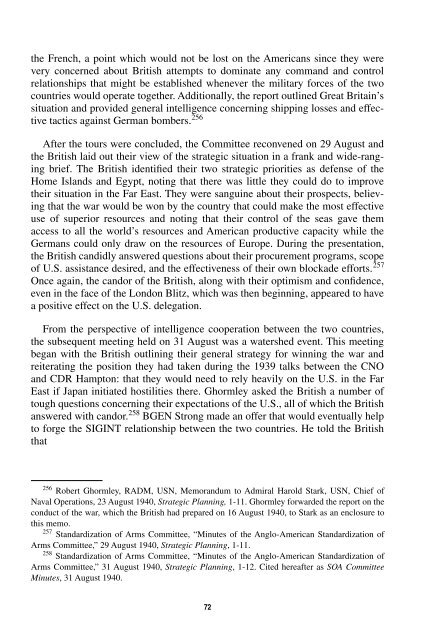The U.S. delegation to the Standardization of Arms talks left the U.S. on12~July 1940 and arrived in England on 15 August. The senior naval representativewas Rear Admiral Robert Ghormley, a former Director of War Plans. Thedelegation was given its orders by the President, who designated Ghormley as thenaval attaché, although this designation was changed to Special Naval Observer(SPECNO) just before his arrival, to highlight the distinction between his roleand that of Kirk. 254 Ghormley was accompanied by Brigadier General G. V.Strong, from the U.S. Army, and Major General C. Emmons, from the U.S. ArmyAir Corps. In their first meeting with the British, held on 20 August 1940,Ghormley made it clear that these were not considered formal talks by the U.S.government and that he and the two generals were there as representatives fromtheir individual Services, not as part of a Joint delegation. The British respondedthat they understood this and told the U.S. delegation that, from 21 to 28 August,they would be taken to the headquarters of the three services to see various operationalunits. The Americans were encouraged to ask questions and were told torequest additions to the agenda if there were organizations or capabilities theywould like to see that were not included on the proposed schedule. 255 As with theDonovan visit, which had concluded earlier in the month, and the Tizard Mission,which would begin in the U.S. just days later, the British policy was to hold littleback from the Americans, hopeful that their openness would produce the cooperationthey sought.On 23 August, Ghormley forwarded a report to the CNO from the British concerningthe conduct of the war to that point. Ghormley did not comment on thereport, but it was exceptionally honest about British objectives throughout thefirst year of the war and the miscalculations that had led to defeat. In this brief,the British reiterated the point that Kirk had made: that the failure to successfullyconclude staff talks with the Dutch and the Belgians before the Germans attackedwas a key element in their defeat on the Continent. The British also made sure theU.S. knew that they had subordinated the British Expeditionary Force (B.E.F.) to254 Albion, 550; COMNAVEU Administrative History, 1-2. Roosevelt appears to have believedthat Ghormley, as the senior naval officer in England, would need to have the status of the navalattaché position. Although Kirk made no official comment about how this action would cause himto lose face with the British, he mentioned it to Donovan, who arranged to have Stark write a letterto the President which outlined the situation and recommended changing Ghormley’s designation toSPECNO. Roosevelt concurred with the decision. Recalling the situation years later, Kirk statedthat this in no way affected his working relationship with Ghormley, who was an old friend. Foradditional information see Harold Stark, ADM, Chief of Naval Operations, Memorandum to thePresident of the United States, 8 August 1940; Kirk Papers, 1; Alan Goodrich Kirk, CAPT, USN,Letter to William Donovan, 14 August 1940, Kirk Papers, 1; Kirk Reminiscences, 166-167.255 Standardization of Arms Committee, “1st Meeting of the Anglo-American Standardization ofArms Committee,” 20 August 1940, Strategic Planning, 1-3; 5. Kirk and the U.S. Army AttachéCOL Raymond E. Lee, were also present at all of the Standardization of Arms Committee meetings.71
the French, a point which would not be lost on the Americans since they werevery concerned about British attempts to dominate any command and controlrelationships that might be established whenever the military forces of the twocountries would operate together. Additionally, the report outlined Great Britain’ssituation and provided general intelligence concerning shipping losses and effectivetactics against German bombers. 256After the tours were concluded, the Committee reconvened on 29 August andthe British laid out their view of the strategic situation in a frank and wide-rangingbrief. The British identified their two strategic priorities as defense of theHome Islands and Egypt, noting that there was little they could do to improvetheir situation in the Far East. They were sanguine about their prospects, believingthat the war would be won by the country that could make the most effectiveuse of superior resources and noting that their control of the seas gave themaccess to all the world’s resources and American productive capacity while theGermans could only draw on the resources of Europe. During the presentation,the British candidly answered questions about their procurement programs, scopeof U.S. assistance desired, and the effectiveness of their own blockade efforts. 257Once again, the candor of the British, along with their optimism and confidence,even in the face of the London Blitz, which was then beginning, appeared to havea positive effect on the U.S. delegation.From the perspective of intelligence cooperation between the two countries,the subsequent meeting held on 31 August was a watershed event. This meetingbegan with the British outlining their general strategy for winning the war andreiterating the position they had taken during the 1939 talks between the CNOand CDR Hampton: that they would need to rely heavily on the U.S. in the FarEast if Japan initiated hostilities there. Ghormley asked the British a number oftough questions concerning their expectations of the U.S., all of which the Britishanswered with candor. 258 BGEN Strong made an offer that would eventually helpto forge the SIGINT relationship between the two countries. He told the Britishthat256 Robert Ghormley, RADM, USN, Memorandum to Admiral Harold Stark, USN, Chief ofNaval Operations, 23 August 1940, Strategic Planning, 1-11. Ghormley forwarded the report on theconduct of the war, which the British had prepared on 16 August 1940, to Stark as an enclosure tothis memo.257Standardization of Arms Committee, “Minutes of the Anglo-American Standardization ofArms Committee,” 29 August 1940, Strategic Planning, 1-11.258 Standardization of Arms Committee, “Minutes of the Anglo-American Standardization ofArms Committee,” 31 August 1940, Strategic Planning, 1-12. Cited hereafter as SOA CommitteeMinutes, 31 August 1940.72
- Page 1 and 2:
COURTING A RELUCTANT ALLYAn Evaluat
- Page 4:
The Joint Military Intelligence Col
- Page 8 and 9:
FOREWORDTo most Americans alive tod
- Page 10 and 11:
PROLOGUESince World War II, the Uni
- Page 12 and 13:
Chapter 1THE STATUS OF INTELLIGENCE
- Page 14 and 15:
action, a propaganda unit, or an ec
- Page 16 and 17:
officers assisted by 20 civilian cl
- Page 18 and 19:
ships in violation of treaty limits
- Page 20 and 21:
assessments. By 1941, ONI was releg
- Page 22 and 23:
might bear on their work.” 39 As
- Page 24 and 25:
ility over time, its operational in
- Page 26 and 27:
Chapter 2U.S.-UK RELATIONS, 1914-19
- Page 28 and 29:
told by the Chief of Naval Operatio
- Page 30 and 31:
ups of the early 20th century. 65 T
- Page 32 and 33: firmly believed that British polici
- Page 34: ecame one of the primary sources of
- Page 37 and 38: of shoring up their strategic weakn
- Page 39 and 40: mon framework for negotiation with
- Page 43 and 44: assuaged British concerns about the
- Page 45 and 46: In the area of intelligence exchang
- Page 47 and 48: clear to the Americans that if they
- Page 49 and 50: in his mind worked against closer c
- Page 51 and 52: praised the fighting spirit of the
- Page 53 and 54: through November of 1940 persuaded
- Page 55 and 56: and Great Britain. His principalcon
- Page 57 and 58: eceived by the British and from the
- Page 59 and 60: gear designed by the British. Altho
- Page 61 and 62: American Attitudes On Intelligence
- Page 63 and 64: information did have an impact on K
- Page 65 and 66: the affair. 183 This lack of resent
- Page 67 and 68: tion exchanges. Even more significa
- Page 69 and 70: nation (BSC) mission, is now availa
- Page 71 and 72: good will and encouraged greater co
- Page 73 and 74: would merely show Donovan “the be
- Page 75 and 76: Lothian passed Hill’s proposal to
- Page 77 and 78: still a powerful influence. While Z
- Page 79 and 80: Since the Tizard Mission had only a
- Page 81: appropriating large increases to th
- Page 85 and 86: equested that RADM Ghormley remain
- Page 87 and 88: when he [Pott] comes to O.N.I. he i
- Page 89 and 90: it was not official U.S. policy. St
- Page 91 and 92: efforts that had begun with the Sta
- Page 93 and 94: high-level ABC-1 staff talks which
- Page 95 and 96: to successfully interpret the instr
- Page 97 and 98: to little more than a nebulous stat
- Page 99 and 100: to offer.” 319 Others in the Brit
- Page 101 and 102: Operational Intelligence Cooperatio
- Page 103 and 104: Godfrey’s main concern was most l
- Page 105 and 106: possesses complementary capabilitie
- Page 107 and 108: 2. Be prepared to give something of
- Page 109 and 110: had in forming its own Joint Intell
- Page 112 and 113: GLOSSARYABC-1ALUSNALondonBGENBSCCAP
- Page 114 and 115: APPENDIX AA NOTE ON SOURCESArchival
- Page 116: APPENDIX BMAJOR EVENTS IN U.S.-UK I
- Page 119 and 120: ________. Foreign Relations of the
- Page 121 and 122: ________. “The Secret of the Chur
- Page 123 and 124: Zacharias, Ellis M., CAPT, USN. Sec
- Page 126 and 127: INDEXAABC-1 Talks 41, 57, 74-75, 78
- Page 128 and 129: IImagery Intelligence (IMINT) 12, 8
- Page 130 and 131: Signals Intelligence(SIGINT) 2-3, 7
- Page 132:
PCN 53512ISBN 0-9656195-9-1
















